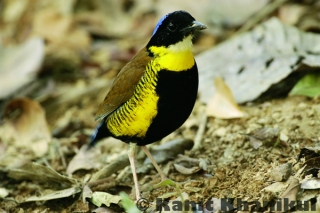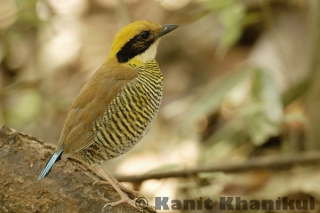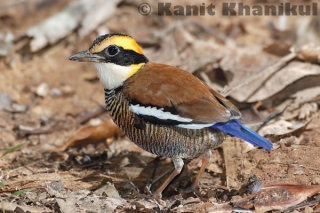Gurney’s Pitta – On the verge of extinction
The Gurney’s Pitta – Thailand’s rarest bird
Gurney’s Pitta in Khao Phra Bang Khram
The dark morning stillness of thick lowland rainforest of Khao Nor Chuchi, Krabi province, is broken by thumping footsteps as two humans move slowly down the trail. We carry heavy photographic equipment to a photo-blind set the previous evening, deep in the jungle. Precipitation is heavy as I set up in the hide. My helper departs quickly, conveying the message to the wildlife in the area that the intruders have left.
The ‘Emerald Pool in Khao Phra Bang Khram
Animals of the night fade into their homes and the ecosystem enters its daylight cycle. As morning light awakens the rainforest, sounds of dripping moisture begin to subside while forest birds and insects start their incessant calls as they have for millions of years.
Well hidden in the blind, I settle down, ever-vigilant for any movement on the forest floor. As the sun arches into the sky, light filters through the forest canopy in patches, illuminating the surroundings. There is a movement near the trail and a Hooded Pitta, common to this forest, hops about looking for food. The striking little blue-green bird with dark brown crown moves closer to the blind seemingly unconcerned about the looming structure.
Gurney’s pitta male
Snapping a few shots of the feathered creature but not wanting to alarm the other inhabitants of the forest, I continue to sit quietly hoping the spirits of the forest will answer my wish.
A morning rain shower passes by but quickly dissipates. As if on cue, a small black and yellow bird magically appears in front of the photo-blind, catching my eye. It’s the creature I’ve been waiting for: the Gurney’s Pitta!
Gurney’s pitta male
The little bird, perhaps sensing danger, quickly disappears into the darkness of the jungle but within minutes, is back again just long enough for only one shot with the camera.
The chance to see and photograph the Gurney’s Pitta, one of the rarest species in the world, has been my goal for several years. And this particular forest is the last known habitat for the bird which is both Thailand ‘s most endangered and a flagship species for the conservation of southern Thailand ‘s lowland rainforest.
Gurney’s pitta female
Gurney’s Pitta (Pitta gurneyi), or sometimes-called Black-breasted Pitta, is a small terrestrial forest bird endemic to Thailand and Burma . The male, with golden brown wings, bright yellow upper breast and flanks, black head and lower breast, white throat and brilliant iridescent blue crown and tail feathers, is striking indeed. The female is less colourful but, nevertheless, also very beautiful.
The species nests in spiny under-story palms laying three to four eggs but usually fledging at most two or three young. They hop about the forest floor and eat mainly insects and earthworms found amongst leaf litter but also take snails and little frogs.
Banded Pitta male
Extremely secretive, they keep as much jungle between themselves and any intruders. When danger approaches, they hop into the underbrush and disappear.
Of the world’s 31 known pittas, found from Africa to the Solomon Islands , and from Japan through Southeast Asia to New Guinea and Australia , 12 species are found in Thailand . They are Gurney’s, Giant, Banded, Hooded, Blue-winged, Blue, Blue-rumped, Eared, Mangrove, Garnet, Rusty-naped and Bar-bellied, of which the first five mentioned are found at Khao Nor Chuchi. The probable geographic origin of the Family Pittidae is in the Indo-Malayan region.
Banded Pitta female
Gurneys Pitta was first discovered in 1875 by W. Davison, a wildlife specimen collector working in Southern Burma for Allan Octavian Hume, a British civil servant working in India , and doyen of ornithology at that time. The bird was named after Humes friend, J.H. Gurney of the English county of Norfolk , and a fellow of the Zoological Society of London.
In the early 20th century, the bird was actually considered common in southern Thailand . Around the 1980s, it was thought to be extinct after no reported sightings had taken place for at least three decades. Then, in 1986, Philip Round, Thailand ‘s top birder, rediscovered the Gurney’s Pitta at Khao Nor Chuchi. It was big news for bird conservation groups and was heard around the world.
Historically, the world range of Gurney’s Pitta was a small concentrated area of lowland semi-evergreen forest along the coast and inland areas of the Thai peninsula, in the provinces of Trang, Krabi, Nakhon Si Thammarat, Surat Thani and Chumphon and Prachuap Khiri Khan. However, the once magnificent lowland tropical forest, its diversity of flora and fauna unsurpassed, has disappeared from most of those areas, due to man’s incessant greed, and his urge to destroy natural forest for the sake of agriculture and profit.
Khao Nor Chuchi, at Khao Pra-Bang Khram Wildlife Sanctuary, Khlong Thom district, Krabi, about 56 kilometres southeast of the provincial capital, is the last known site for Gurney’s Pitta in Thailand . Khao Pra-Bang Khram, with its headquarters at Ban Bang Tieo village, was established as a non-hunting area in 1987 by the Royal Forest Department (RFD), at the behest of Bangkok Bird Club (now Bird Conservation Society of Thailand-BCST), specifically in order to protect Gurney’s Pitta. It was upgraded to a wildlife sanctuary in 1993, with a total area of 183 square kilometres.
The Emerald Pool (Sa Morakot) within Khao Pra-Bang Khram Wildlife Sanctuary is a beauty spot visited by many local and foreign tourists. There are many trails open to nature explorers and bird watchers known as Thung Tieo Nature Trail Network. At least 318 different bird species have been recorded here.
The site’s alternative name, Khao Nor Chuchi, comes from the 650-metre-high conical mountain which overlooks the area. Bird photographers also come to Khao Nor Chuchi after images of the Gurney’s.
Many people, after travelling thousands of kilometres from different parts of the world, have left very disappointed after not seeing or photographing it. Gurney’s Pitta is a tough bird even to see, let alone photograph.
Although the species once occupied about 40 square kilometres of this area, most of the extreme lowlands where they live and breed were excluded from the sanctuary. As a result, forest is still being destroyed to grow rubber, oil palm and coffee, and human settlement has taken up most of the area.
Villagers still engage in poaching of animal and forest products from the reserved forest. On the day I photograph this Gurney’s Pitta, I still heard a gunshot.
Pitta numbers at Khao Nor Chuchi have declined drastically in the last two decades from an estimated 40 pairs in 1986, down to 21 pairs in 1992. This slide was due primarily to uncontrolled forest destruction, perhaps abetted by capture of the species for the black market trade in forest birds, and even for some government-run zoos.
According to BirdLife International’s Red Data there were only 11 breeding pairs and two extra males remaining in mid-2000. This year, only four to five nests have been found and sightings of individual birds have been minimal. At one nest that was abandoned, local birdwatchers found bird-nets put there by villagers who used the nets to capture the birds.
The species was also found along the coast and inland at the most southern tip of Burma but no reports of them have come from there since about 1914 and it is anybody’s guess whether it still survives. No surveys can be done due to inaccessibility of the area and danger of land mines. Tough government regulations have also kept most researchers away from the area.
BirdLife International, BirdLife Denmark , and NGOs such as BCST and the Oriental Bird Club have implemented a number of projects at Khao Nor Chuchi, in collaboration with RFDs Wildlife Conservation Division. However, these have slowed, but not halted, new settlements and further forest clearance.
Ultimately, unless the wildlife sanctuary can be expanded to encompass all remaining lowland forest, and previously cleared areas reforested, Gurney’s Pitta faces a very bleak outlook for survival. This magnificent bird could disappear before we know it and that would be a sad day for conservation in Thailand .
With just 11 breeding pairs left, the Gurney’s Pitta is very likely to be the first species to go extinct in this millennium, unless all parties concerned join hands in protecting it. On the day this male bird was photographed, a gunshot was heard.








